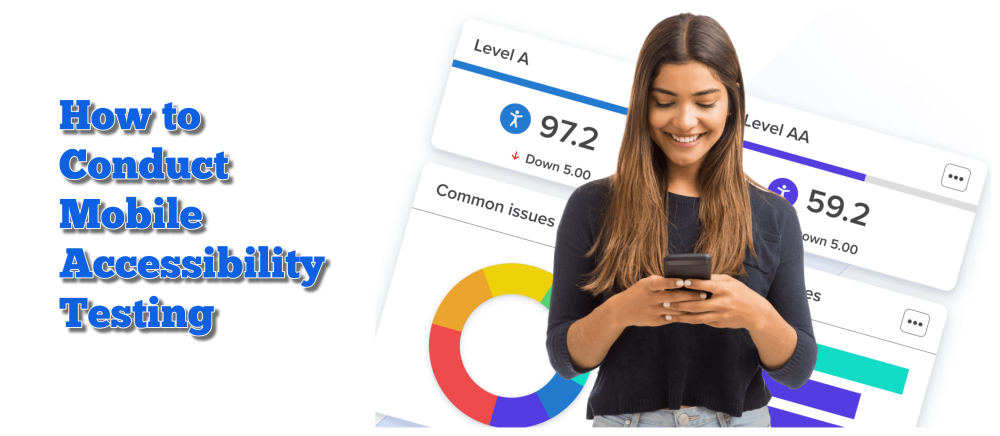How to Conduct Mobile Accessibility Testing + Detailed Checklist

Have you ever tried to use a smartphone or tablet with a physical disability, or assisted someone who has? It can be a frustrating experience, with small buttons and screens that are difficult to navigate and interact with.
What if there was a way to ensure that mobile devices were accessible to everyone, regardless of their physical abilities? This is what mobile accessibility testing is all about.
But what exactly is mobile accessibility testing, and why is it important?
Let’s take a deeper dive into this critical aspect of ensuring that the ever-expanding world of mobile technology is inclusive for all users.
What Is Mobile Accessibility Testing?
Mobile accessibility testing evaluates the usability of a mobile application or website for users with disabilities. They include individuals who are blind or have low vision, hearing loss, or limited mobility.
The goal is to ensure that these individuals can access the same information and functionality as those without disabilities, using assistive technologies such as screen readers, screen magnifiers, and voice recognition software.
Mobile accessibility testing can be done manually by having individuals with disabilities test the application or website, or it can be automated using tools that simulate the use of assistive technologies.
This process is important in software development to ensure that the application or website is accessible to the widest possible audience.
Manual vs Automated Mobile Accessibility Testing
Manual mobile accessibility testing involves manually checking a mobile application or website for compliance with accessibility standards and guidelines, such as the Web Content Accessibility Guidelines (WCAG).
It usually entails manually checking the accessibility of a mobile application or website using a specific device and browser. This process involves manually navigating the site or application and using various tools and techniques to ensure that it is usable by people with disabilities.
Automated mobile accessibility testing, on the other hand, involves using software tools to automatically check if a mobile application or website is accessible. These tools scan the site or application and report any issues or potential problems that may make it difficult for people with disabilities to use.
Automated testing is generally faster and more efficient than manual testing, but it may not catch all accessibility issues.
Mobile Accessibility Testing Checklist

Here is a detailed mobile accessibility checklist that can be used to test the accessibility of mobile applications and websites on both iOS and Android devices:
Keyboard Accessibility:
- Can the user navigate through all controls and interactive elements using a keyboard?
- Is the keyboard focus visible on all interactive elements?
- Are all interactive elements reachable using the tab key?
- Is the tab order logical and intuitive?
Touch Target Size and Spacing:
- Are all touch targets (e.g., buttons, links) at least 44×44 pixels in size and spaced appropriately?
- Do all touch targets have sufficient space around them to prevent accidental taps?
- Color and Contrast:
- Is the contrast ratio between text and its background at least 4.5:1 for normal text and 3:1 for large text according to Web Content Accessibility Guidelines?
- Are links and buttons clearly distinguishable from surrounding text and elements?
- Is the color alone not used to convey crucial information?
Text and Font Size:
- Is the text legible and easy to read at the default font size?
- Can the user increase the font size without the layout breaking?
See what fonts are accessible for people with visual impairments
Alternative Text:
- Is alternative text provided for all images, including decorative images?
- Is the alternative text concise and meaningful?
Learn how to add an ALT attribute to an image
Headings:
- Are headings used appropriately to create a logical hierarchy of content?
- Do headings follow a logical and sequential order?
Form Labels:
- Are form labels explicitly associated with their corresponding form controls?
- Are form labels descriptive and concise?
This checklist is not exhaustive, but it covers key areas to consider when testing the accessibility of mobile applications and websites. It is vital to also manually test and use assistive technologies, such as screen readers, to ensure that the application or website is fully accessible to all users.
Need Mobile Accessibility Testing Tools?
There are many tools available for testing the accessibility of mobile applications and websites on iOS and Android devices. These tools can help identify issues related to the accessibility of the user interface, such as problems with color contrast, font sizes, and headings.
Here are some examples of mobile accessibility testing tools for iOS and Android:
- Accessibility Scanner: This is a free tool for Android devices that analyzes the accessibility of an app and provides suggestions for improvement.
- TalkBack: This is a screen reader for Android devices that tests the accessibility of mobile apps and websites.
- Deque WorldSpace Attest: This is a paid tool for testing the accessibility of mobile apps and websites on iOS and Android devices.
- Accessibility Insights: This is a free tool for testing the accessibility of mobile apps and websites on iOS and Android devices.
- AccVerify: This is a paid tool for testing the accessibility of mobile apps on both iOS and Android devices. It offers both automated and manual testing options.
- aXe: This is an open-source tool for testing the accessibility of mobile apps and websites on iOS and Android devices. It can be used as a browser extension or as a standalone application.
- Accessibility Testing Framework: This is a free tool for testing the accessibility of Android apps. It allows users to write custom tests and integrates with the Android testing framework.
- TestFairy: This is a paid platform for testing the functionality and performance of mobile apps on iOS and Android devices. It includes features for testing the accessibility of apps, such as the ability to record audio and touch events during testing.
- ATK: This is a free, open-source tool for testing the accessibility of Android apps. It includes a set of automated tests and tools for manual testing.
It is important to note that while these tools can help identify accessibility issues, they should not be relied upon exclusively. It is also important to manually test mobile applications and websites to ensure they are fully accessible to all users.
In conclusion, mobile accessibility testing is a critical aspect of ensuring that mobile technology is inclusive for all users, including individuals with disabilities. It involves evaluating the usability of a mobile application or website for users with disabilities, such as those who are blind or have low vision, hearing loss, or limited mobility.
This process can be done manually or using automated tools, and it helps to ensure that everyone can access the same information and functionality using assistive technologies. By implementing mobile accessibility testing, we can ensure that the ever-expanding world of mobile technology is accessible to everyone, regardless of their physical abilities.
Spread the word by sharing this article!
Leave a Reply